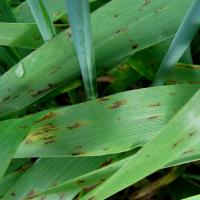Diagnosing net type net blotch
Net-type net blotch is a stubble-borne fungal foliar disease occurring more frequently in the medium and high rainfall areas of the WA wheatbelt. It can reduce grain yield and quality.
What to look for
- Blotched, yellowing and dead leaves generally evenly distributed across the paddock.
Paddock
- Small dark brown spots that elongate and produce fine dark brown streaks along and across the leaf blades and leaf sheaths, creating a distinctive net-like pattern. Lesions may also form larger elongated blotches, often with straight sides.
- The area surrounding the spots frequently goes yellow and severely affected leaves wither rapidly.
- Older leaves are affected first and more severely.
- In severe cases heads are infected.
- Severe leaf or head infection can result in shrivelled grain.
Plant
What else could it be
| Condition | Similarities | Differences |
|---|---|---|
| Diagnosing spot type net blotch | Brown spots. Similarities only occur during the early stages of infection. | Spots expand into net-pattern lesions (Net-type net blotch). |
| Diagnosing physiological leaf spot in barley | Brown spots. Similarities only occur during the early stages of infection. | Spots expand into net-pattern lesions (Net-type net blotch). |
| Diagnosing boron toxicity in barley | Brown spots. | Spots expand into net-pattern lesions (Net-type net blotch). |
Where did it come from?

Contaminated seed

Green bridge
- The fungus is carried from season to season on infected barley and wild grass residues. Regrowth barley or infected seed can act as an initial source of infection.
- Early in the season, wind-blown spores may spread over long distances to infect early unprotected sown crops.
- After initial infection spores are produced on leaves when conditions are moist, then spread from leaf to leaf by wind. Serious disease results when there is frequent rainfall and a dense canopy that retains moisture on the leaves for a longer period of time. Drying spring conditions slow the cycle of infection.
- Potassium deficient crops are more susceptible to leaf disease.
Management strategies

Resistant varieties

Stubble management

Seed treatment


Spraying foliar

Green bridge control
- Avoid cropping barley on barley in medium to high rainfall areas.
- Avoid growing highly susceptible varieties.
- Reduce stubble residue carry-over as much as possible.
- Appropriate seed dressings may be effective against seed borne infection but is ineffective against an infection coming from airborne spores.
- Certain foliar fungicides containing triazole and/or strobilurin are effective in net-type net blotch control, check label registrations.
- Treat for potassium deficiency if economic.
- Control barley grass.
See also
Where to go for expert help
Page last updated: Thursday, 16 April 2015 - 10:11am





